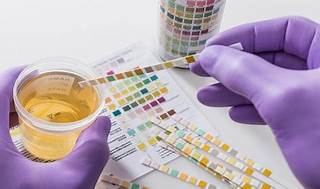The healthcare provider prescribes a 24-hour urine specimen to be collected for creatinine clearance. The client is eager to go home and tells the nurse that the first sample was put in the urinal 2 hours ago. Which action should the nurse implement?
Start collecting the specimen with the next void.
Begin the collection the next day.
Observe the sample for sediment.
Empty the sample into the 24-hour container.
The Correct Answer is A
The correct answer is A. Start collecting the specimen with the next void.
Choice A reason: The 4-hour urine collection for creatinine clearance should start with an empty bladder. The first urine of the day is discarded and the time is noted. All subsequent urine for the next 4 hours, including the first urine the following day, should be collected. If the first sample was put in the urinal hours ago and was not collected, the nurse should start collecting the specimen with the next void.
Choice B reason: Beginning the collection the next day would delay the test and may not be necessary. The test should ideally start after the first urine of the day is discarded.
Choice C reason: Observing the sample for sediment is not typically part of the procedure for a 4-hour urine collection for creatinine clearance. The focus is on collecting all urine for a specified period, not on the physical characteristics of the sample.
Choice D reason: Emptying the sample into the 4-hour container would be incorrect if the sample was the first urine of the day, which should be discarded. The collection should start with the next void.

Nursing Test Bank
Naxlex Comprehensive Predictor Exams
Related Questions
Correct Answer is B
Explanation
Choice A reason: Completing an adverse occurrence/incident report is not the most important action to implement. It may be necessary to document the incident later, but it does not address the immediate safety issue of the client.
Choice B reason: Demonstrating proper securing of the restraints is the best action to implement. It corrects the mistake made by the UAP and ensures that the client is not at risk of injury or entrapment. It also educates the UAP on the correct technique and policy for applying restraints.
Choice C reason: Ensuring that the restraints are not too tight is a relevant action to implement, but not the most important one. It is part of the ongoing assessment and care of the client who is restrained, but it does not correct the improper securing of the restraints to the bedside rails.
Choice D reason: Initiating the facility's restraint flow sheet is a required action to implement, but not the most important one. It is part of the documentation and evaluation of the client who is restrained, but it does not address the immediate safety issue of the client.
Correct Answer is A
Explanation
Choice A reason:This option is the most therapeutic because it is open-ended and invites the client to express feelings and experiences about the visit. By encouraging the client to talk, the nurse provides an opportunity for the client to explore emotions, which could explain why they became isolative afterward. Open-ended questions also demonstrate interest and support, which fosters trust and promotes communication in therapeutic relationships.
Choice B reason:Asking if the client would like to talk is supportive, but it is too vague and closed-ended. The client may simply answer “yes” or “no,” which does not facilitate deeper exploration of feelings. While it offers availability, it is not as therapeutic as directly encouraging discussion about the observed event, the visit.
Choice C reason: This is a less therapeutic response as it assumes that the client enjoyed the visit. It may not reflect the client's true feelings or experiences. It also limits the client's expression to positive aspects only.
Choice D reason: This is a non-therapeutic response as it labels the client's emotion without validation. It may not accurately describe the client's feeling or situation. It also closes the communication by making a statement instead of asking a question.
Whether you are a student looking to ace your exams or a practicing nurse seeking to enhance your expertise , our nursing education contents will empower you with the confidence and competence to make a difference in the lives of patients and become a respected leader in the healthcare field.
Visit Naxlex, invest in your future and unlock endless possibilities with our unparalleled nursing education contents today
Report Wrong Answer on the Current Question
Do you disagree with the answer? If yes, what is your expected answer? Explain.
Kindly be descriptive with the issue you are facing.
